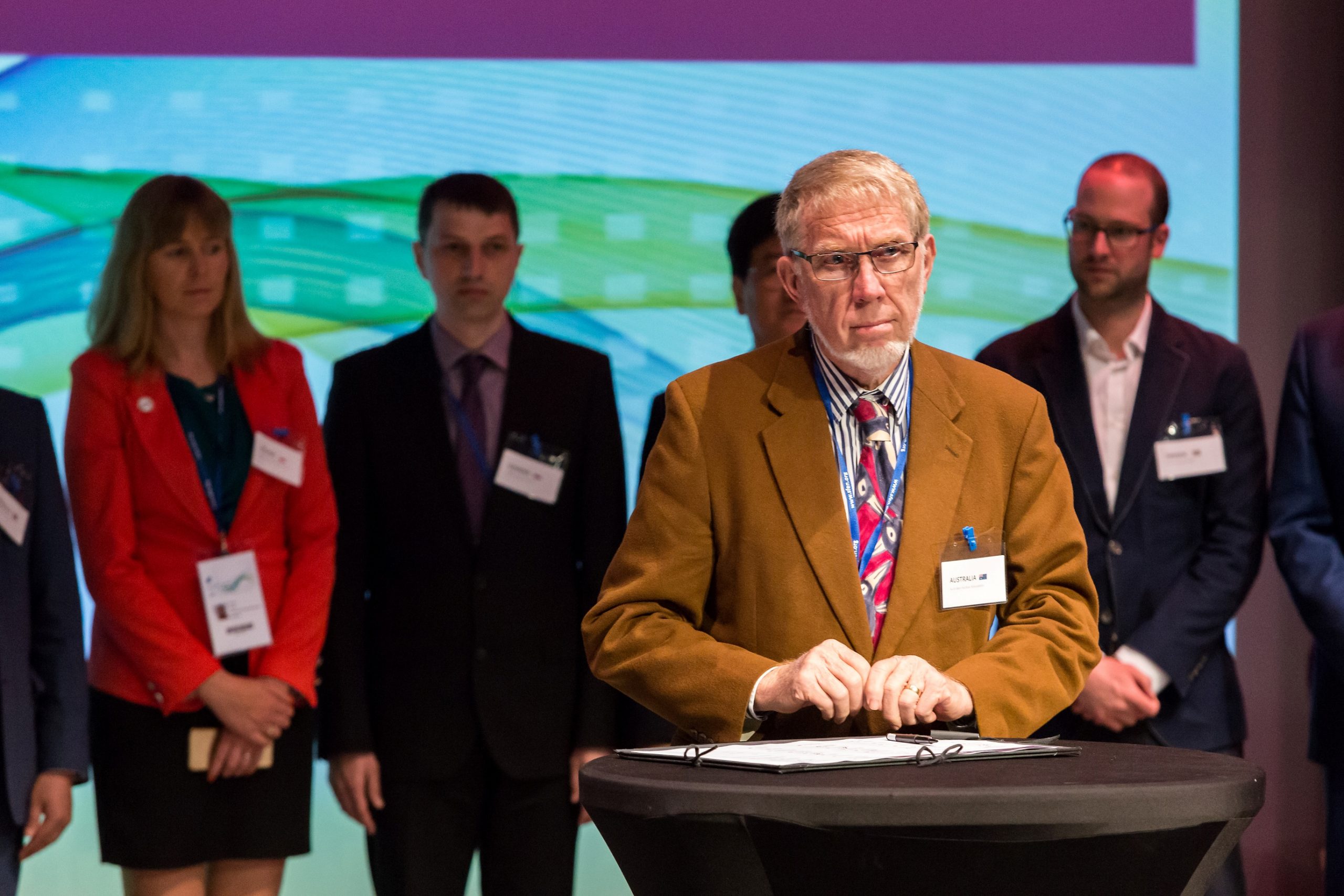
01 Mar Chapter 2 – Nuclear Energy replaces Coal Plants in Australia
1.Introduction
This is the second of a three part blog which looks at a plan for real carbon reductions in Australia’s electricity generating system.
Part 1 dealt where Australia’s greenhouse gas emissions come from, what our targets should be,
In this Part 2 we look at how we can achieve these very low emissions in the electricity sector using nuclear energy and
In Part 3 we’ll look at where nuclear power plants could be sited in Australia.
2. Coal plant retirements
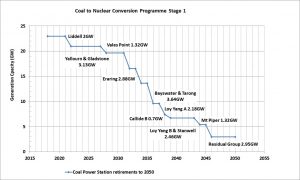 Attribution: Dates for retirements obtained from Energy Policy Institute of Australia
Attribution: Dates for retirements obtained from Energy Policy Institute of Australia
This image shows the likely timescale of the retirements of existing coal fired generators from the National Electricity Market. These retirements total some 20 gigawatts of capacity and will be completed some time after 2046. They are retiring because they are worn out. The operation of our National Electricity Market has failed to attract investment in any new generating capacity that is not underwritten by power purchase guarantees or subsidies and so new coal is not being built.
3. New Nuclear Plants to replace coal
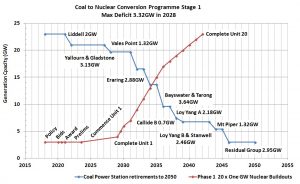 Attribution: Nuclear build programme by Nuclear For Climate Australia
Attribution: Nuclear build programme by Nuclear For Climate Australia
The opportunity therefore exists to replace all those coal plants with an equivalent amount of nuclear energy. This image shows the progressive replacement of those coal plants with 20 GW of nuclear energy which requires the construction of 22GW of capacity. We have allowed 11 years for the completion of the first unit and for the completion of the entire programme by 2042.
That’s a very modest rate of completion averaging onlt 1.2 GW or just over one nuclear power plant per year.
4. French Programme
This can be compared with the French programme in the 1970’s to late 1990’s where they achieved a rate of 2.4GW per year and that’s before personal computers entered the work place.
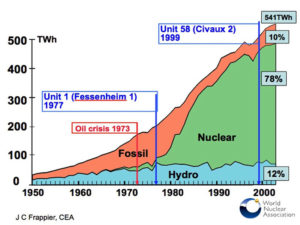 Attribution: J.C. Frappier, French Alternative Energies and Atomic Energy Commission (CEA) and World Nuclear Association
Attribution: J.C. Frappier, French Alternative Energies and Atomic Energy Commission (CEA) and World Nuclear Association
- First French Pressurised Water Nuclear Power plant – Fessenheim 1 in 1977
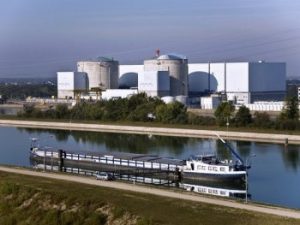 Attribution: World Nuclear Association
Attribution: World Nuclear Association
- Last nuclear power plant Civaux 2 commissioned in 1999
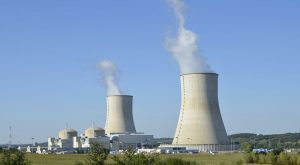 Attribution: Association de la Visite d’Entreprise (AVE)
Attribution: Association de la Visite d’Entreprise (AVE)
5. Emissions benefits of Nuclear Energy – France vs Germany
Attribution: Mark Nelson, mwn3925@gmail.com, data from Fraunhofe ISE and RTE France
Despite paying nearly twice the price for electricity in Germany compared to France and having incurred a cost to date of €500 billion the results are not looking good for carbon reductions. As this graph shows, emissions in Germany remain at around 580 gr CO2/kWh compared to those in France at around 50 gr. CO2/kWh.
Germany is increasing its dependence on Russian gas with projects such as the Nordstream 2.0 gas pipeline. This is no solution to emissions reductions especially when fugitive emissions from Russian gas can make it a worse source than coal.
6. Nuclear Benefits for Australia
We have run a model developed by my colleague Dr Robert Barr which takes the actual diversified wind and solar PV Generation patterns, amplifies these in proportion to the required capacity and matches these generated outputs to the NEM Load.
We used this model to compare two routes to a low carbon future:
The first used increasing amounts of wind and solar with storage. These necessarily required backup with varying amounts of gas and hydropower to overcome the fluctuations in wind and solar availability.
The second route was devoted to rolling out increasing amounts of nuclear energy. Due to its limited ability to load follow, nuclear energy was combined with solar PV, storage, hydropower and gas peaking plants.
7. Retail Electricity Costs
In the following image we see the results of electricity costs of these two systems.
We looked at the total system as a whole to arrive at what we call the system levelized cost of energy.
We added in the costs of additional transmission as well as the impact of underutilised generating plant such as gas and pumped storage. It’s the cost of all these underutilised bits that significantly add to the cost of a system based on intermittent renewable energy as Germany is finding out.
From our early stage analysis we find that as our electricity generators produce less carbon the system based on renewables is at least 70% more expensive than one based on nuclear energy.
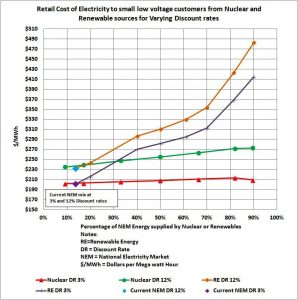 Attribution: Analysis by Nuclear for Climate Australia using Energy Model Created by Electric Power Consulting
Attribution: Analysis by Nuclear for Climate Australia using Energy Model Created by Electric Power Consulting
8. Carbon Abatement Costs
The really big gains with the use of nuclear energy are shown in this next image.
After all, the whole reason for this endeavour is to reduce emissions and so with nuclear energy we see a dramatic reduction in carbon abatement costs of nuclear compared to those obtained with a system based on variable renewable energy.
Our analysis indicates that at very high levels of nuclear or renewables such as 82% of supply, carbon abatement is some seven times less expensive with nuclear energy.


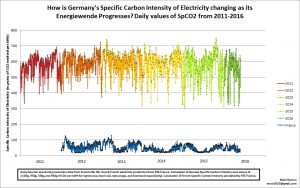
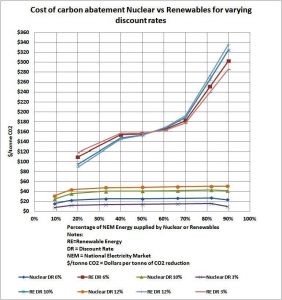
Peter Cunningham
Posted at 18:42h, 01 MarchA BRILLIANT effort Robert – and CREDIT to the young fella who is doing the video work.
Spot on focus, depth of field, colour balance, audio – clear images – picture in picture – logical and uncomplicated presentation ……….. VERY professional.
This series is a MUST watch for those interested in doing something TRULY effective to look after our planet – air, water and land.
Putting money into SOLID power generation is the key to grid distributed power, whereas so-called “renewables” are disproportionally fickle and disruptive in networks. However of great use with battery storage in more remote areas and small settlements. It is FOLLY to mix the two, as Victoria and South Aust have discovered (but won’t admit). Germany isn’t too pleased with the false promises either!
WELL DONE ROB AND AV CHAP.
Will Eddowes
Posted at 12:20h, 02 MarchHow Scott Morrison can claim that we will meet all our carbon reduction commitments “at a canter” is hard to see. I guess getting rid of manufacturing helps!
The programmed retirement of coal plants is scary. Unfortunately we have to allow for the huge resistance of public opinion in Australia to nuclear power – even though we seem happy to export uranium and give others the task of dealing with waste. I believe we need to establish a first nuclear plant on an “experimental” basis as a starter to gain local technical expertise and to acknowledge that we need to change the public’s perception. I fear that we may end up with a number of brown-outs and black-outs to wake up the pollies and others!
We also need to pursue renewables and, particularly, storage which is their achilles heel. Improved batteries or hydrogen production may solve this but still seem to be a long way off.
John Merory
Posted at 15:19h, 30 DecemberNuclear electric power always full of promise but never the downsides discussed or admitted. Germany looked into all its high level nuclear waste options and nothing was safe. Previously secure drums of waste are now leaking into the groundwater. Too hot to handle.
I prefer nuclear fusion power which provides all the electricity we need for our household and transport and I can still export 5 mWh to the grid per year, without needing to import. No high level nuclear waste problems, minimal maintenance, no brownouts or blackouts. Our household nuclear power station is the Sun, which transmits its energy to our photovoltaic panels on our house roof during the day when our power needs are greatest, and fills our relatively small storage Li battery to cover our energy needs at night. No greenhouse gas pollution from us! In fact the native trees of local provenance and other plants which we helped establish in our garden and local area draw down CO2.